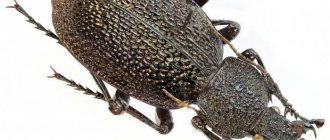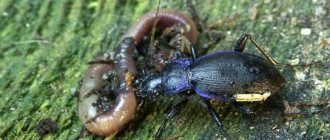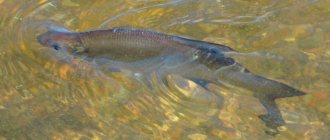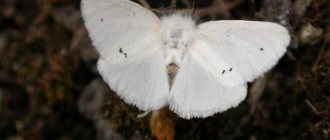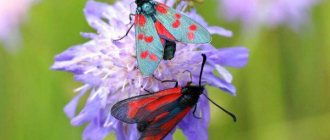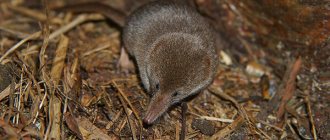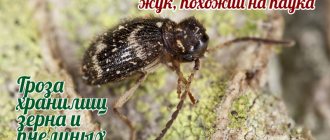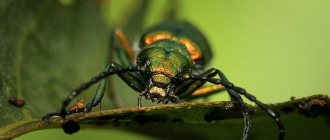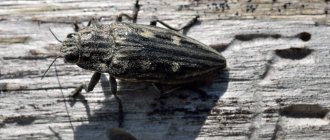Morphology
Imago
Most ground beetles have a similar, characteristic body shape, but some specialized groups differ significantly from the typical appearance. Their uniform morphology makes identification difficult, and confident identification of many species is only possible through dissection.
Black (shagreen) ground beetle
Most often, ground beetles are black with a metallic sheen; however, iridescence of different colors is not uncommon, and sometimes they have differently colored spots on the body. The size varies significantly from 1–2 mm to almost 10 cm. In Russia, representatives of the genus Trechus are among the smallest species. The largest in Europe are Carabus gigas and Carabus scabrosus (snail-eater), reaching 5–6 cm in length.
Crimean ground beetle - a subspecies of the species snail-eater
Head
The head is slightly flattened in the dorsal-ventral direction, has a protruding (protruded) mouthparts with well-developed crescent-shaped mandibles. The eyes are usually well developed and protruding, but in underground and cave species they are reduced or absent. The antennae are almost always filiform and consist of 11 segments. Attached between the eyes and the base of the mandibles, but closer in horses.
Head of a representative of the genus Carabus
Pronotum
The pronotum of most ground beetles has a rather characteristic shield shape with a well-defined edge. Smooth or sculptured. The posterior angles are often elongated, pointed or rounded and are an important taxonomic character.
Notiophilus rufipes from the genus Bigeyes has a head with eyes wider than the pronotum (subfamily Plotinniki)
Elytra and wings
The elytra completely cover the abdomen. Most often they are sculptured with longitudinal grooves. The spaces (between the grooves) are solid or differently dotted. Many species have fused elytra, reduced wings and cannot fly.
Forest ground beetle
Legs
The legs are long, adapted for running. The paw formula is 5-5-5. The hind coxa bisects the first ventral sternite (synapomorphy of Adephaga). The fore tibia usually has at its apex a specialized organ with comb-like setae for cleaning the antennae.
Leg of a male Loricera pilicornis
Atypical forms
Highly specialized species usually differ from the typical forms of ground beetles. For example, representatives of the tribe Cychrini specialize in hunting snails. Due to this, their head and chest are narrowed and elongated, which allows them to penetrate the snail's shell and pull it out.
Cychrus cylindricollis
Some ground beetles have developed the ability to dig. A typical example is the tribe Scaritini, which has wide and flattened tibiae with spine-like growths on the sides that help them dig.
Scarites sp.
Ground beetles from the subfamily Paussinae are myrmecophiles, adapted to coexist with ants. Many of their representatives have strongly flattened antennae and legs.
The subfamily Cicindelinae, sometimes considered a separate family, is also distinct from other ground beetles. They have large eyes, which make their heads wider than their narrow pronotum. They are often brightly colored and have distinctive patterns on their elytra.
Cicindela japonica
The highly flattened Mormolyce phyllodes from Southeast Asia is adapted to life under the bark of trees.
Fiddle beetle (leaf-shaped ground beetle) Mormolyce phyllodes, Malaysia
Larvae
The larvae are campodeoid, most often yellow-brown or black in color. The body is more or less sclerotized. Like adults, they have forward-directed mouthparts, adapted to a predatory lifestyle. The antennae are short, with 3–5 segments. There are usually six simple lateral eyes on each side, sometimes fewer or none at all. The abdomen consists of 10 segments, on the 9th there is a pair of urogomphs (appendages).
Manticora scabra larva, South Africa
Reproduction and lifespan
The ground beetle is a long-lived beetle - from 3 to 5 years. The life cycle of an insect gradually passes from egg to larva, pupa and adult. The breeding season begins after the spring mating season, which usually takes place in the month of April.
Bread ground beetle
One female lays a single clutch of 50-80 eggs directly into the soil to a depth of 3 cm. To do this, she chooses a moist place with fertile soil. Larvae weighing up to 160 mg and up to 2 cm in length appear after 13-14 days.
They have 6 short claw-shaped legs. Their white color turns purple-black after 10 hours. After 40 hours from birth, the jaws of small predators already have the power to eat terrestrial mollusks. Clinging tightly to the prey, despite its persistence and secretion of mucus and foam, it burrows into the soil with it and eats it.
Larval development is completed by the end of summer. The next stage occurs - pupation, which lasts 15-25 days. The naked body of the pupa resembles an adult beetle in appearance.
A characteristic feature is tufts of protruding setae on the back and lateral surface of the abdominal segment. The pupa is mostly contained in a cradle made of soil or substrate.
In winter it enters the adult state with a duration of 2-3 years. The first appearance of young individuals depends on climatic conditions and is observed in May-June. This mainly occurs at the beginning of the ripening of the grain crop.
Mass appearance can be seen in the milky stage of winter crop ripeness. In August it enters diapause - a stop in the formation process - and burrows into the ground up to 40 cm.
Chemical protection
Adults have a pair of pygidium glands at the end of the abdomen, which secrete a protective secretion if the beetle is disturbed. The composition of the substances released varies significantly among different species - various organic acids, quinones, hydrogen peroxide and many others.
Krasotel fragrant
Chemical defense has reached the greatest perfection in bombardier beetles (subfamily Brachininae). In case of danger, they point their abdomen towards the attacker and release a stream of irritating hot liquid, accompanied by a clearly audible sound, hence their name. The "shot" is achieved by mixing two inactive ingredients in a heavily sclerotized chamber at the end of the abdomen. The ingredients react explosively, bursting out under pressure and reaching temperatures of up to 100°C. Similar means of defense by explosion have also evolved independently in the subfamily Paussinae.
Bombardier crackling
Security status
The number of shagreen ground beetles is declining in all habitats. Several factors contribute to the decline of the species:
- Deforestation, which is a natural biotype of beetles.
- Recreational loads in habitats.
- Lack of wings and weak migratory ability of beetles.
- Treatment of forests with chemicals.
The shagreen ground beetle is listed in the Red Book of the Chuvash Republic, Belarus, Lithuania, and the Smolensk region of the Russian Federation. To preserve the species, it is necessary to prohibit collecting insects, reconstruct parks and forests in beetle habitats, and reduce recreational use.
Breeding in captivity
To combat agricultural pests, predatory beetles are kept in cages. Several pairs of ground beetles are placed in aquariums with soil and a layer of moss. Females lay eggs. Young larvae are caught and kept separately to avoid cannibalism. Adults and larvae are fed with earthworms, slugs, and snails. Beetles need water to quench their thirst and rinse their mouths. For wintering, the container with the larvae is placed in the refrigerator or basement. In spring, the insect pupates. After 6-12 days, adults crawl out of the soil and can be released into the area attacked by pests. Ground beetles are difficult to breed in captivity and their industrial use is limited.
Phylogeny
Phylogenetic tree of the ground beetle family (after DR Maddison et al., 1999)
Ground beetles are closely related to the trachypachidae family (Trachypachidae CG Thomson, 1857), with which they have common ancestors. Regarding the intrafamily relationships of ground beetles, there are significant differences between different scientists and scientific schools, which is also reflected in the taxonomy of the family. The study of phylogenetic relationships using 18S ribosomal DNA sequencing methodology shows some nuances of the relationship of different groups of ground beetles. According to research, the oldest branches of the family are the subfamilies Carabinae and Siagoninae, which are located separately from other groups. From a common ancestor comes a group of subfamilies: Nebriinae, Loricerinae, Omophroninae, Psydrinae, Promecognathinae and Apotominae. The subfamily of bighead ground beetles (Broscinae) is close to them, however, it is located somewhat apart and is more evolutionarily developed. A separate group consists of the subfamilies Patrobinae and Trechinae, which are relatively young and developed from a common ancestor. The most specialized and evolutionarily developed of these is the scarita subfamily (Scaritinae). A completely different group of the family consists of the most evolutionarily progressive subfamilies of psidrins (Psydrinae), brachininae (Brachininae) and harpalinae (Harpalinae), and psidrins are much more isolated from the last two.
Big-headed ground beetle
Description of ground beetles
Name: Ground beetles Lat.:
CarabidaeClass: Insects - Insecta Order: Coleoptera - Coleoptera
| Habitats: | everywhere, depending on the type |
| Dangerous for: | insects and gastropods, there are pests |
| Attitude towards people: | Depending on the species, there are representatives of the Red Book and pests that are hunted |
Representatives of the ground beetle family number more than 50 tons of species, and more and more new representatives appear every year. Among the large family there are predators, pests and phytophages.
Ecology
Of all the abiotic factors, the main limiting environmental factor for the distribution of ground beetles is soil moisture. The vast majority of species prefer moist biotopes with low temperatures, which is due to the rapid loss of water by the body of ground beetles. This is especially true for predatory species that need to replenish their body’s water supply by directly drinking water. Phytophagous ground beetles replenish water shortages by eating plant tissues where there is enough plant sap. Some parasitoid species replenish the lack of water at the expense of the host's hemolymph. A small group of species has adapted to conserving water and is able to live in saline biotopes - the coasts of salt lakes, salt marshes, and sea beaches.
Purple ground beetle
Lebia the little crusader
Why is it dangerous for plants in the country house and in the apartment?
Herbivorous ground beetles cause damage to many plants, it all depends on the type of beetle. The harvest is destroyed not only by adults, but also by larvae. This applies to bread beetles and hairy ground beetles. It is these 2 species that are dangerous for plants in the country house and in the apartment. Unlike ordinary ground beetles, these eat not garden pests, but plants. Adult beetles gnaw the ear, the grain falls to the ground, then they eat it. In half a month, one adult beetle is capable of destroying from 30 to 40 grains.
In an apartment, ground beetles are attracted to the food left on the table, as well as various cereals. Some bugs may enter your home based on the smell of pet food.
Habitat
The bread ground beetle prefers high humidity and moderate air temperatures. Therefore, it is not found in arid and hot areas. She chooses regions with a temperate climate. Its habitat is from the countries of North Africa to the southern part of Sweden and England. But the most favorable conditions for its reproduction are in Moldova, the south of Ukraine and the European part of Russia.
Nutrition
The ground beetle lives in forests, parks, gardens and personal plots, where there is a large accumulation of all kinds of food. The favorite “dishes” of beetles were and remain:
- caterpillars;
- larvae;
- aphid;
- slugs;
- snails
The principle of hunting and capturing prey is extremely simple. When a beetle discovers its “dinner,” a special fluid is activated in the glands hidden in its powerful jaws. The beetle sprays its victim with this composition, waits a few minutes and then begins to eat.
The injected composition immobilizes the insect and softens it into a kind of pulp, which the beetle easily absorbs. After a hearty lunch, the ground beetle can return to its shelter and not come out for several days in a row to digest the food. After complete digestion, after two or three days, the beetle goes hunting again.
Some species, such as amara and ophorus, prefer exclusively plant foods. Their diet includes leaves and soft parts of plants. Such beetles can harm crop plants.
